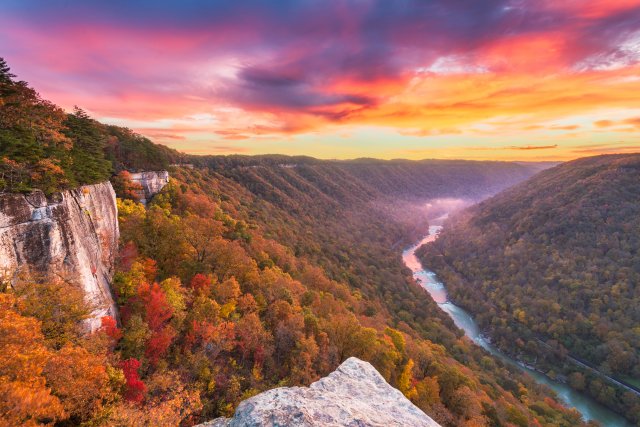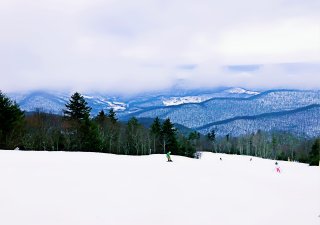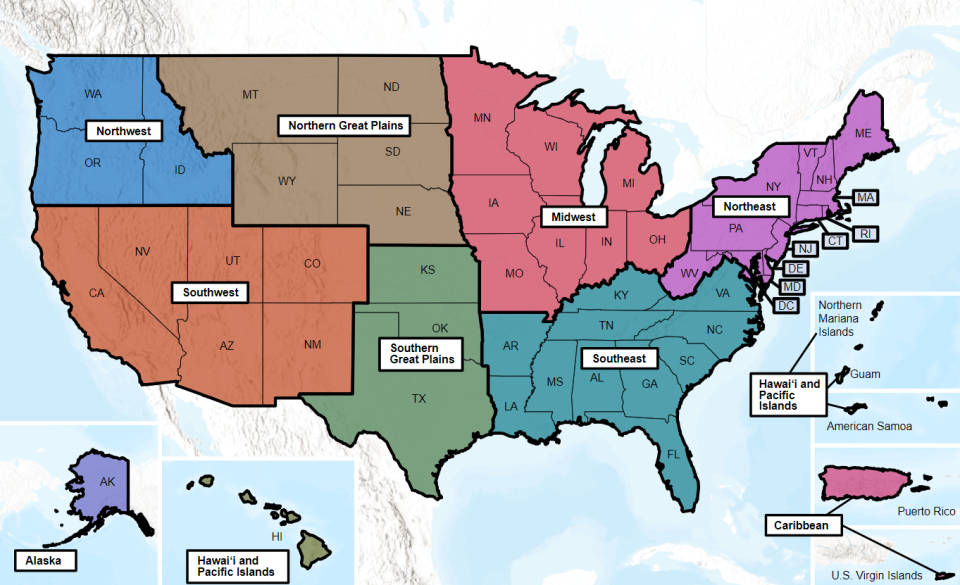Climate Change Connections: West Virginia (Appalachian Recreation)
Climate change is impacting all regions and sectors of the United States. The State and Regional Climate Change Connections resource highlights climate change connections to culturally, ecologically, or economically important features of each state and territory. The content on this page provides an illustrative example. As climate change will affect each state and territory in diverse ways, this resource only describes a small portion of these risks. For more comprehensive information about regional climate impacts, please visit the Fifth National Climate Assessment and Climate Change Impacts by Sector.
On this page:
Introduction: An Outdoor Oasis and Economic Engine in West Virginia
At more than 300 million years old,1 the Appalachian Mountain range is the oldest major mountain range in North America. West Virginia is the only state located entirely within the Appalachian region.2 The Appalachian Mountains are home to many plant and animal species, including the black bear and red spruce. Its distinct landscape offered isolation, waterways, forests, and an abundance of food for Indigenous Peoples and early American settlers.3 The Appalachian Mountains of West Virginia have inspired various art forms that have woven their way into American culture, such as bluegrass music, flat foot mountain dancing, and folklore.4

The Appalachian Mountains offer activities such as rock climbing at Seneca Rocks, skiing down the slopes of Snowshoe Mountain, hiking around Blackwater Falls, and trout fishing in the Elk River.5 The beautiful landscape and wealth of outdoor recreation opportunities in the Appalachian Mountains draws many visitors, and tourism is an important economic driver in West Virginia.6 West Virginia is home to 36 state parks and six national park system sites, which attract many visitors annually and contribute significantly to the state economy.7 The outdoor recreational industry supported more than 20,000 jobs in West Virginia in 2022.8
Climate Impacts: Warming Temperatures and Changing Precipitation Patterns Can Impact Outdoor Recreation
West Virginia has moderate winter temperatures and warm summers.9 These conditions are part of what makes the state a destination for various forms of outdoor recreation. However, climate change is expected to affect many of the region’s ecosystems. Currently, average summer high temperatures in West Virginia range from around 85°F in areas near the Ohio River to less than 80°F in the east-central mountains.9 Climate change is expected to make the number of hot days—with temperatures 95°F and above—more common.9 Over the next century, heat waves (abnormally hot weather that usually lasts two or more days) are also expected to become more intense, while cold periods are expected to become less intense.9

Rising temperatures are threatening many Appalachian flora and fauna. For example, populations of brook trout, West Virginia’s only native trout species and a common catch for anglers, have declined due to a variety of factors, including habitat loss, drying stream beds, higher water temperatures, and floods, which can amplified by climate change.10,11 A single flood event can injure and kill mature trout and completely destroy an entire juvenile population.11 Declining trout populations could have economic consequences. Anglers can contribute to local economies with spending on equipment and travel, and they generate revenue for the West Virginia Division of Natural Resources through the purchase of fishing licenses and trout stamps.11 Climate change impacts on the availability of coldwater fish habitat is expected to cause economic losses for the recreational fishing industry in many parts of the United States.12,13
While average precipitation in West Virginia has remained largely consistent—with some variation—over the past century, the intensity of heavy rainfall has increased in recent years.9 Climate change can affect precipitation intensity and frequency. As average temperatures at the Earth’s surface rise, more evaporation and transpiration occur and add more moisture to the air, which in turn increases overall precipitation. In recent decades, more rainfall has been occurring as intense single-day rainfall events. The state’s wettest period on record occurred between 2016 and 2020, averaging about 52 inches of rainfall per year.9 Annual precipitation is expected to continue to increase during the spring and summer seasons along with the frequency of heavy precipitation events, increasing the risk of more frequent and intense flooding events in the future.9 Heavy rainfall and flooding can damage recreational infrastructure like trails and create multiple safety hazards.14 Flooding can cause soil erosion and transport agricultural runoff and industrial pollutants into waterways, creating unsafe conditions for both humans and wildlife.15 In 2016, when over 10 inches of rain fell within a two-day period, the Meadow, Cherry, and Elk rivers experienced a once-in-a-thousand-year flood that killed at least 23 people and destroyed infrastructure.16 Following the flood, public health officials warned the public against water recreation due to the increased risk of pathogens and infection. 17

Warming temperatures are also expected to lead to a shorter snow season in many parts of the country, as well as increases in the percentage of precipitation falling as rain instead of snow.18,19 This can affect winter recreation, such as skiing, snowboarding, and ice climbing, as well as the local economies that depend on winter tourism. While ski resorts can turn to making their own snow as snowpack declines, this process also requires sufficiently cold temperatures.
Taking Action: Managing a Changing Landscape
Addressing climate change requires reducing greenhouse gas emissions while preparing for and protecting against current and future climate impacts. Communities, public officials, and individuals in every part of the United States can continue to explore and implement climate adaptation and mitigation measures. In West Virginia and across the Appalachian Mountains, natural resource managers and park officials are taking to steps protect ecosystems in a changing climate, including:
- Climate outreach and education. Many Appalachian parks are continuing to expand educational outreach for visitors, including New River Gorge National Park and Preserve, which is part of the Climate Friendly Parks Program.20 Visiting parks and recreating in the Appalachian Mountains is an opportunity for many to learn about local climate change impacts and ways to be part of climate solutions.
- Habitat restoration and wildlife management. To respond to changing conditions, natural resource and wildlife managers are taking steps to protect habitat and build resilience for some key species.21 The West Virginia Department of Natural Resources has implemented trout hatcheries and habitat restoration efforts to help maintain the trout supply for anglers while also conserving the fish population.11,12,22
To learn more about climate change impacts in West Virginia and the Northeast region, see Chapter 21 of the Fifth National Climate Assessment.
Related Resources
- EPA Climate Change Indicators: Heavy Precipitation
- State Climate Summaries 2022: West Virginia (NOAA)
- Effects of Climate Change at New River Gorge National Park and Preserve (NPS)
References
1 National Park Service. (2020). Convergent plate boundaries—Collisional mountain ranges. Geology. Retrieved November 30, 2023, from https://www.nps.gov/subjects/geology/plate-tectonics-collisional-mountain-ranges.htm
2 Appalachian Regional Commission. (2021). Appalachian counties served by ARC. Retrieved November 30, 2023, from https://www.arc.gov/appalachian-counties-served-by-arc/
3 Yarnell, S. L. (1998). The Southern Appalachians: A history of the landscape (General Technical Report SRS-18). U.S. Department of Agriculture, Forest Service, Southern Research Station.
4 Grohsgal, L. W. (2016). Keeping tradition alive: Taking steps to preserve Appalachian folk culture. The National Endowment for the Humanities. Retrieved November 30, 2023, from https://www.neh.gov/divisions/preservation/featured-project/keeping-tradition-alive-taking-steps-preserve-appalachian-folk-culture
5 West Virginia Public Broadcasting. (2019). September 26, 1863: The first West Virginia legislature adopts state motto and great seal. West Virginia Public Broadcasting. Retrieved November 30, 2023, from https://wvpublic.org/september-26-1863-the-first-west-virginia-legislature-adopts-state-motto-and-great-seal/
6 WV News. (2023, September 12). West Virginia tourism hits record high with $7 billion economic impact in 2022. https://www.wvnews.com/news/wvnews/west-virginia-tourism-hits-record-high-with-7-billion-economic-impact-in-2022/article_ca920295-daef-59fa-9dd2-6df20edb2243.html
7 West Virginia Department of Tourism. (2022). State of the tourism industry: 2022 annual report. https://wvtourism.com/wp-content/uploads/2023/02/2023.01.31_WVTourism_2022-Annual-Report_FINAL.pdf
8 U.S. Bureau of Economic Analysis. (2022). Outdoor recreation satellite account, U.S. and states, 2022. https://www.bea.gov/data/special-topics/outdoor-recreation
9 Runkle, J., Kunkel, K. E., Frankson, R., Stewart, B. C., & Spaccio, J. (2022). West Virginia state climate summary 2022 (NOAA Technical Report NESDIS 150-WV). NOAA National Environmental Satellite, Data, and Information Service. https://statesummaries.ncics.org/chapter/wv
10Andrew, R. G., Schwinghamer, C. W., Hartman, K. J., & Briggs, E. E. (2022). Climate change influence on brook trout populations in the Central Appalachians. Ecology of Freshwater Fish, 31(4), 710–725. https://doi.org/10.1111/eff.12664
11West Virginia Department of Natural Resources. (n.d.). West Virginia trout management plan 2022-2031. https://wvdnr.gov/wp-content/uploads/2022/04/2022.04.25-DNR_Trout-Management-Plan.pdf
12Dolesh, R. J. (2017, October 5). Climate change is changing the face of outdoor recreation. National Recreation and Park Association. https://www.nrpa.org/parks-recreation-magazine/2017/october/climate-change-is-changing-the-face-of-outdoor-recreation/
13Jones, R., Travers, C., Rodgers, C., Lazar, B., English, E., Lipton, J., Vogel, J., Strzepek, K., & Martinich, J. (2013). Climate change impacts on freshwater recreational fishing in the United States. Mitigation and Adaptation Strategies for Global Change, 18(6), 731–758. https://doi.org/10.1007/s11027-012-9385-3
14 O’Toole D, Brandt LA, Janowiak MK, Schmitt KM, Shannon PD, Leopold PR, Handler SD, Ontl TA, Swanston CW. (2019) Climate Change Adaptation Strategies and Approaches for Outdoor Recreation. Sustainability. 11(24): 7030. https://doi.org/10.3390/su11247030
15 Butler, P. R., Iverson, L., Thompson, F. R., Brandt, L., Handler, S., Janowiak, M., Shannon, P. D., Swanston, C., Karriker, K., Bartig, J., Connolly, S., Dijak, W., Bearer, S., Blatt, S., Brandon, A., Byers, E., Coon, C., Culbreth, T., Daly, J., … Zegre, N. (2015). Central Appalachians forest ecosystem vulnerability assessment and synthesis: A report from the Central Appalachians Climate Change Response Framework project (General Technical Report NRS-146). U.S. Forest Service. https://doi.org/10.2737/NRS-GTR-146
16NOAA. (2016). “Thousand-year” downpour led to deadly West Virginia floods. Climate.gov. Retrieved December 4, 2023, from http://www.climate.gov/news-features/event-tracker/thousand-year-downpour-led-deadly-west-virginia-floods
17Charleston Gazette-Mail. (2016, July 19). Flooding may cause dangerous germs in recreational water, officials say. Charleston Gazette-Mail. https://www.wvgazettemail.com/news/health/flooding-may-cause-dangerous-germs-in-recreational-water-officials-say/article_29eb6590-06a2-528c-9324-117fc0a82dca.html
18Wobus, C., Small, E. E., Hosterman, H., Mills, D., Stein, J., Rissing, M., Jones, R., Duckworth, M., Hall, R., Kolian, M., Creason, J., & Martinich, J. (2017). Projected climate change impacts on skiing and snowmobiling: A case study of the United States. Global Environmental Change, 45, 1–14. https://doi.org/10.1016/j.gloenvcha.2017.04.006
19EPA. (2023). Climate change indicators: Snowfall. Retrieved February 20, 2024, from https://www.epa.gov/climate-indicators/climate-change-indicators-snowfall
20 National Park Service & U.S. Department of the Interior. (n.d.). New River Gorge National River Action Plan. https://www.nps.gov/subjects/climatechange/upload/NERI-CFP-Action-Plan-508Compliant.pdf
21U.S. Fish & Wildlife Service. (n.d.). Appalachian Fish and Wildlife Conservation Office. Retrieved January 23, 2024, from https://www.fws.gov/office/appalachian-fish-and-wildlife-conservation
22 Appalachian Landscape Climate Advisory Group. (2022). Conserving an intact and enduring Appalachian landscape: Designing a corridor in response to climate change. https://appalachiantrail.org/wp-content/uploads/2022/07/Appalachian-Landscape-Corridor-Report_July-2022.pdf

